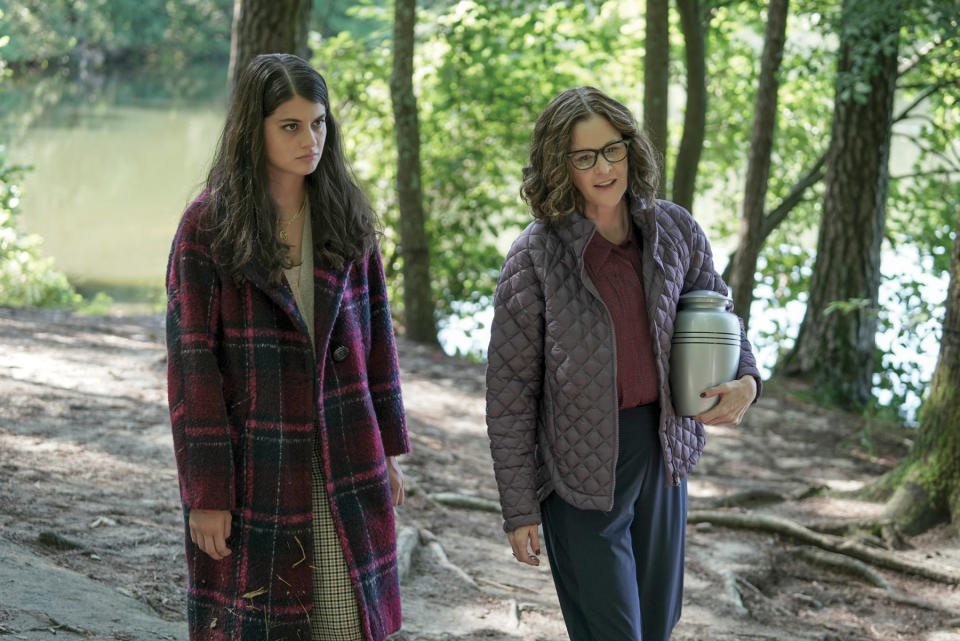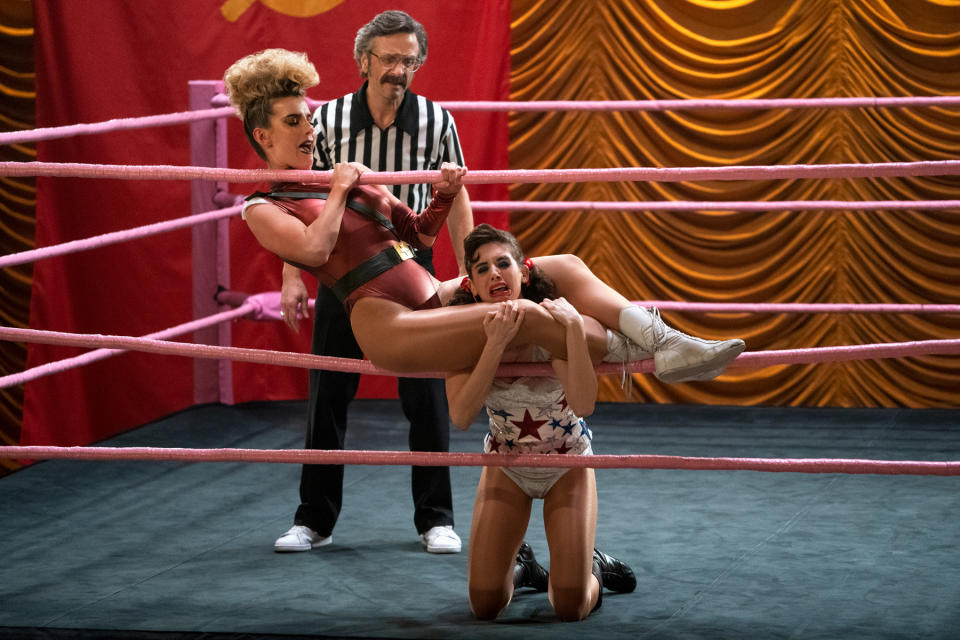‘Minx’ and the Painful Death of Peak TV

In the new season of the Seventies workplace comedy Minx, Joyce Prigger’s fortunes couldn’t be more on the rise. The titular magazine, which pairs feminist journalism with full frontal male photo spreads, is thriving, turning Joyce into a minor celebrity who hobnobs with Linda Ronstadt, Gloria Steinem, and other icons of the period. When Rolling Stone comes to profile her (in an episode with more than a whiff of Almost Famous), she admits to the reporter that getting everything she wants has only left her fearing that it can all be taken away.
That exchange is one of many throughout Season Two that are accidentally a commentary on Minx the real TV series as opposed to Minx the fictional skin mag. When it debuted last spring on what was then called HBO Max, the show attracted positive reviews (like this one) and enthusiastic social media response. Streaming ratings are a black box — which is one of many reasons that both the writers and actors are on strike at the moment — so no one on the outside knows how many people were actually watching. But a second season was ordered, and all seemed as positive for the series as it did for Joyce.
More from Rolling Stone
'Minx' Is Back in Business and 'Better Than Ever' With First Season 2 Trailer
'Spider-Man: Across the Spider-Verse' Is Pure Superhero-Movie Bliss
Flesh and Boners: 'Minx' Is Your New Favorite Feminism-Meets-Porn Comedy
Then Minx, like a whole lot of recent television, ran headfirst into the buzzsaw that is David Zaslav.
Zaslav, the chairman of the combined, ungainly entertainment conglomerate known as Warner Bros. Discovery, has become such an infamous Hollywood figure in so short a time that his name is practically a verb. “To Zaslav” is “to abruptly, arbitrarily make TV shows and movies disappear in an attempt to save a few bucks.”
Zaslav’s first big move was to bury a $90 million movie about Batgirl, deciding that the tax write-off would be more valuable than letting anyone see it. Since then, he’s lit project after project on fire, vanishing shows from the Max archives while also pulling the plug on active projects — one of which was Minx. The show was in the middle of filming the eighth and final episode of its second season when word came down that they were preemptively canceled. Never mind that the money had already been spent to make seven-plus episodes of television; the balance sheet declared that it was more valuable dead than alive.
For Minx, there’s a happy ending: because the show was produced by Lionsgate, rather than a WBD subsidiary, it was able to find a new home over at Lionsgate-backed Starz, which paid to complete that last episode, and will begin airing Season Two today. Some other shows that got Zaslav’ed at competing networks have similarly managed to find homes. AMC decided against airing the completed second season of its Courtney B. Vance legal drama 61st Street, but the new CW execs, desperate for any programming they don’t have to pay to produce themselves, picked it up. Showtime dropped both its Shailene Woodley-led ensemble drama Three Women and Andrew Scott as con man Tom Ripley in Ripley, the latest take on Patricia Highsmith’s novels; Three Women also moved to Starz, while Netflix will be streaming Ripley. But other shows have, for the moment, gone into the memory hole along with Batgirl, like the fourth and final season of TNT’s oft-retooled series adaptation of Snowpiercer.
Shows being canceled and picked up elsewhere is nothing new in television. Before Cobra Kai was a big hit on Netflix, it was part of a failed attempt by YouTube to get into the high-priced scripted originals game. You was dropped by Lifetime before finding a home on Netflix as well. Once upon a time, Buffy the Vampire Slayer moved from the WB to UPN. Last fall, Peacock announced that it would not order a third season of its critically acclaimed Tina Fey-produced comedy Girls5Eva, but Netflix swooped in to produce more, just as the streamer once upon a time rescued Fey’s Unbreakable Kimmy Schmidt when NBC realized they didn’t want it after an entire first season had been made.
What’s different is the sheer amount of shows that have suddenly been rendered homeless — or, in the case of a lot of archival material, that vanished altogether. Every few days, it seems, we hear news of another streamer that’s cutting way back on its library titles. Max was first with this, but Hulu, Disney+, and others have similarly begun purging their archives, often of shows that only just concluded a recent season. Freeform canceled the charming comedy Single Drunk Female weeks after its second season finished airing; within a day, both seasons were gone from its streaming home at Hulu(*).

(*) In a cruel twist, when I lamented this recently, several people told me that they were still seeing promos for the show while watching other things on Hulu. Left hand, meet right hand.
In many specific cases, these shows are not going to be missed; how many people might still be seeking out HBO’s short-lived Seventies music industry drama Vinyl, or Disney+’s bland Turner & Hooch sequel series?
But they all speak to two larger problems, one for the business and one for the audience.
The former is that this amount of original scripted programming we’ve gotten over the past few years simply was not sustainable economically. When FX boss John Landgraf referred to this era as “Peak TV,” he was alluding to the concept of “Peak oil,” as in the moment when we would hit the maximum rate of global oil production, and output would begin an irreversible decline. He originally assumed the peak in this case would come in 2018 or 2019. But we appear to have finally arrived at that awkward moment. Even before the writers went on strike, followed by the actors, it was clear the industry was undergoing a retrenchment. The days when every network and streamer could be pumping out every possible show for every possible niche are done. The finances just don’t make sense, and everyone seems to be realizing that they threw out a lucrative business model — one supported by various combinations of cable company carriage fees, subscriptions, and advertising — in favor of one that demands constant, perpetual audience growth. That’s why we’ve seen Netflix and others roll out lower subscription tiers that feature commercial breaks. It’s why FAST (short for “free, ad-supported streaming television”) channels like Tubi, Pluto, and Freevee are doing well (often offering “channels” with old school regularly-scheduled programming, to spare viewers the decision fatigue that comes from endless menu options), and why big companies like Disney are trying to get viewers to bundle multiple streaming subscriptions together. Time is a flat circle. All of this has happened before, and it will happen again.
Minx is a fun little show with a lot of charming performances — not just Lovibond, but Jake Johnson (as Joyce’s unapologetic partner in pornography), Lennon Parham (as Joyce’s sister, who goes all-in on early Seventies sexual liberation), Oscar Montoya (as a queer photographer who recognizes that the magazine is being bought by gay men at least as much as by straight women), and more — but the “little” is doing a lot of the heavy lifting here. I’m glad this season gets to air, and I’m hopeful Starz can find a way to keep it going. But it already feels like an artifact of another time — not the period in which the story is set, but the late 2010s/early 2020s TV ecosystem that allowed it to exist in the first place.
As for the audience, it’s not just that we’re being asked to recreate the cable bundle on our own in order to keep up with everything. It’s that one after another, the unspoken promises of the earlier phase of the streaming era are being broken. TV shows getting to run for as long as their creators want them to? Tell that to fans of GLOW or Y: The Last Man. The chance to enjoy shows without commercial interruption? Technically still there, but you have to pay more for it now. And the notion that every show will live in perpetuity on one streamer or another, there to binge whenever you’re ready for it? Yeah, good luck with that.

That latter one in some ways feels the most frustrating of all the changes. The way TV used to work in its Pleistocene epoch, is that when most series aired their last episode, that was that. A small group of either big hits (I Love Lucy, Seinfeld) or shows that were initially less popular but proved surprisingly sticky (Star Trek, The Brady Bunch) would continue to be available in repeat syndication. Almost everything else just vanished. The early 2000s DVD boom changed that, but many series never got physical media versions of every season. The streaming arms race provided incentive for every new service to bulk up on library titles as evidence of why they deserved your subscription fee, and to keep new original series around in perpetuity. Maybe you never got around to watching something in its original run, or maybe you’ve been waiting for the right moment to revisit an old favorite, but there was a sense of reassurance that you could when you finally found the right moment and mood to do it. That sense of security is gone now. Whether we’re talking about relatively recent shows or pre-Netflix ones, nothing is safe. Anything but the biggest of big hits can vanish at any time.
Some may look on this implosion with a sense of relief. The sheer tonnage of original programming created a sense of FOMO in many TV viewers — even professional ones like me — who simply didn’t have the time to watch all of the things their friends were raving about. And the pruning of every streaming library could minimize the sense of decision paralysis that comes with scrolling through dozens upon dozens of menu rows, always worried that the perfect choice is just a few clicks away. But however overwhelming Peak TV could feel at times, it was also comforting. It took more effort to find the right show for you, but inevitably it was out there, whether something new or something buried deep in the library. You didn’t have to worry about surprise cancellations, or any of the old ways the business ran. That time is done, though. Minx gets to live another day, but cases like it are going to become rarer and rarer.
Best of Rolling Stone

